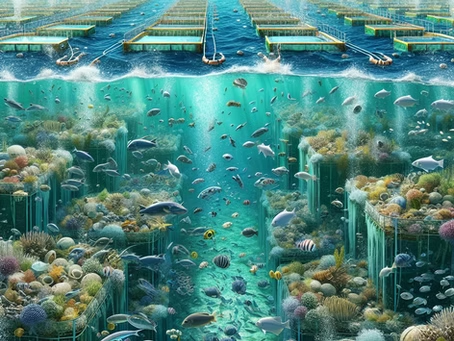Reimagining Aquaculture for People and Planet
Sustainable aquaculture represents a transformative approach to seafood production that actively contributes to ecosystem health rather than degrading it. By learning from past mistakes in terrestrial agriculture, today’s innovative aquaculture operations are designed to work in harmony with natural systems—restoring habitats, enhancing biodiversity, and providing economic opportunities for coastal communities. Through strategic species selection, advanced closed-system technologies, and careful site placement, modern aquaculture can produce nutrient-rich seafood while improving water quality, creating habitat for wild species, and sequestering carbon. This paradigm shift challenges traditional perceptions of farming and demonstrates how food production can become a net-positive force for environmental regeneration and social equity.
Environmental Benefits of Sustainable Aquaculture
When properly designed and managed, aquaculture systems can deliver significant ecological advantages.
Ecosystem Restoration
Strategic aquaculture operations can actively restore degraded environments through practices like:
• Farming filter-feeding shellfish that improve water quality
• Cultivating seaweeds that absorb excess nutrients and provide habitat
• Creating structured environments that support wild fish populations
Biodiversity Enhancement
Sustainable farms can increase local biodiversity by:
• Providing habitat complexity through farming structures
• Serving as de facto protected areas when properly managed
• Supporting wild populations through spillover effects
Climate Resilience
Aquaculture contributes to climate solutions through:
• Carbon sequestration via seaweed and shellfish cultivation
• Reduced food miles when production occurs near markets
• Lower carbon footprint compared to terrestrial animal protein
Social and Economic Benefits
Sustainable aquaculture delivers meaningful benefits beyond environmental improvements.
Job Creation and Economic Development
The aquaculture sector generates employment across multiple domains:
• Direct farming operations and management
• Processing, distribution, and marketing
• Equipment manufacturing and technology development
• Research, monitoring, and regulatory compliance
Community Development
Local communities benefit through:
• Enhanced food security and access to nutritious protein
• Economic diversification in coastal regions
• Opportunities for traditional fishing communities to transition to sustainable practices
• Improved infrastructure and services supported by industry growth
Health and Nutrition
Sustainable aquaculture addresses critical human health needs:
• Providing reliable sources of omega-3 fatty acids and essential nutrients
• Producing seafood with lower contaminant levels through controlled environments
• Increasing access to affordable protein for growing populations
Implementation Strategies for Sustainable Aquaculture
Achieving truly sustainable operations requires careful planning and innovation.
Strategic Site Selection
Environmentally responsible siting avoids sensitive habitats while maximizing ecological benefits:
• Prioritizing areas where farming can improve water quality
• Selecting locations with natural water exchange and appropriate conditions
• Avoiding critical habitats like mangroves, coral reefs, and seagrass beds
Technology and Innovation
Advanced technologies enable more sustainable production:
• Closed-containment systems that prevent escapes and pollution
• Automated feeding systems that minimize waste
• AI and sensor networks for real-time monitoring
• Renewable energy integration to reduce carbon footprint
Species Selection
Choosing appropriate species is crucial for sustainability:
• Native species that fit naturally within local ecosystems
• Low-trophic species that require minimal feed inputs
• Species with high market demand and nutritional value
• Organisms that provide ecological services (filter feeders, algae)
Overcoming Challenges
The industry must address several barriers to achieve widespread sustainability.
Regulatory Frameworks
Effective governance requires:
• Science-based standards for environmental performance
• Streamlined permitting processes that encourage best practices
• International cooperation on sustainability certifications
Public Perception
Building trust through:
• Transparency in operations and environmental performance
• Education about sustainable aquaculture benefits
• Third-party certification and verification programs
Economic Viability
Ensuring financial sustainability through:
• Technological innovations that reduce operating costs
• Market recognition and premium pricing for sustainable products
• Government incentives for environmentally superior practices
The Future of Sustainable Aquaculture
Emerging trends point toward increasingly regenerative practices.
Integrated Multi-Trophic Aquaculture
Combining species that create symbiotic relationships:
• Using waste from fed species to nourish extractive species
• Maximizing resource utilization and minimizing environmental impact
• Creating more diverse and resilient farming systems
Climate-Adaptive Practices
Preparing for changing conditions through:
• Selective breeding for temperature and disease resistance
• Developing alternative feeds that reduce reliance on wild fisheries
• Implementing infrastructure designed for changing sea conditions
Community-Centered Models
Ensuring local benefits through:
• Cooperative ownership structures
• Fair labor practices and community investment
• Integration with local food systems and markets

